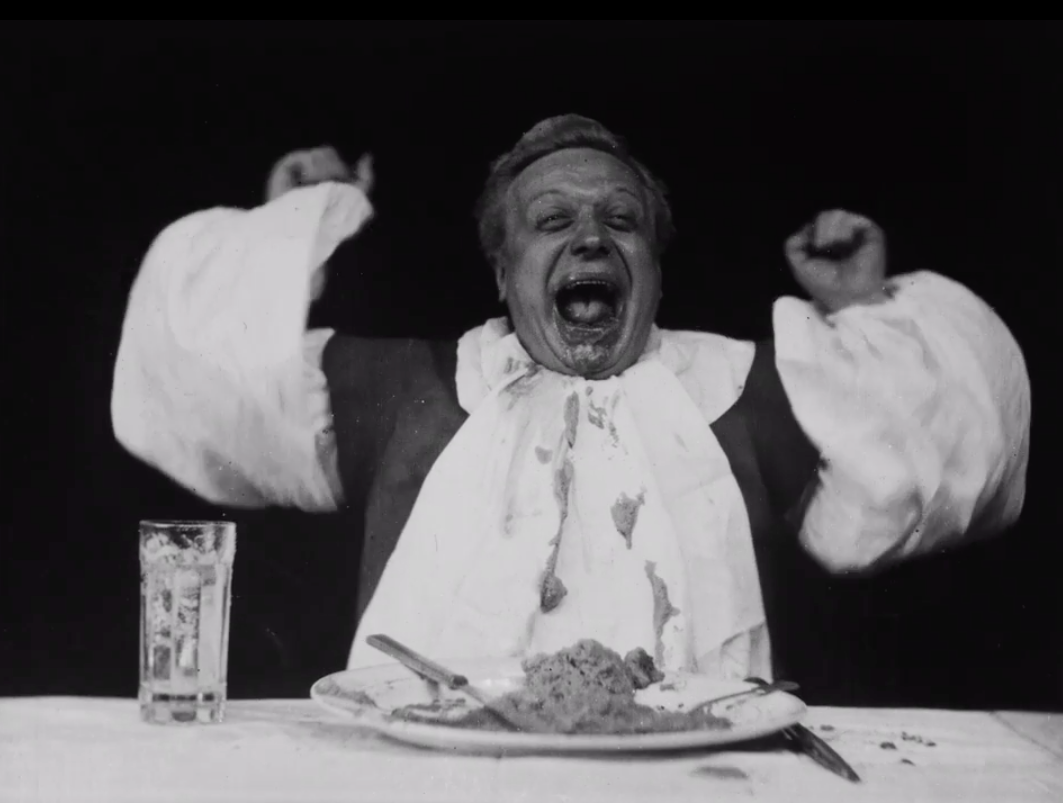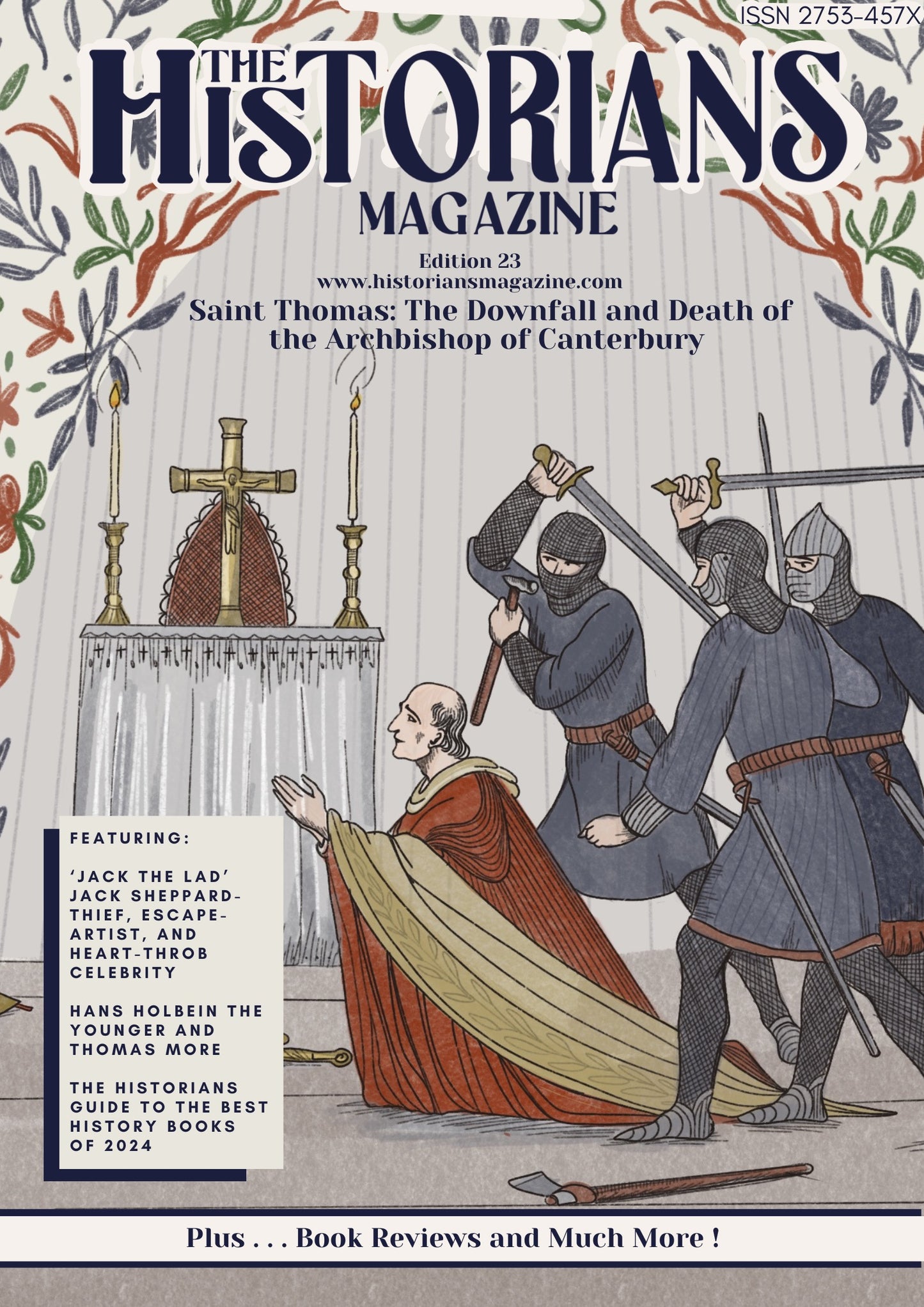
Were the Victorians really ‘not amused’? Oddity and comedy in late-Victorian cinema
Share
Part I: The seedling days of cinema
It’s 1899. A man is seated at a table, eating his dinner. It’s an everyday, pedestrian scene except this man is ravenous. He messily devours an unappetising meal. Food is dripping off his contorted face, eyes bulging wide. It’s a gluttonous frenzy as he washes down the feast with a pint of beer, grinning back at the camera with deep satisfaction.
This is ‘Herbert Campbell as Little Bobby’ (1899), a short film designed to both amuse and disgust viewers with this enthusiastic display of poor table manners. Lasting less than a minute, its runtime is easily dwarfed by the lengthy spectacles of modern-day cinema. Yet these comedy shorts are not unlike the short-form video entertainment that dominates our screen time today.
Films like ‘Little Bobby’ also show the Victorians at their most playful and experimental in the seedling days of cinema. Indeed, this was the era of the ‘living picture craze’, a phrase coined by the British Journal of Photography in 1896 in reaction to the accelerating invention and spectacle of Victorian filmmaking. The BFI’s archive alone holds more than 700 films made in Britain during this period (1895-1901), and many more films have sadly been lost to time.
This flurry of creative output at the tail-end of Queen Victoria’s reign was the product of “tangled” moments of innovation where filmmakers homed in on technologies in an “uneven pattern” of borrowed ideas, according to BFI Curator Bryony Dixon. But these early films also built upon the rich, visual landscape of pre-cinema. Here, Victorians witnessed an explosion of magic lantern shows, panoramas, dioramas, stereoscopes, and the list goes on. These inventive devices of Victorian pre-cinema created a magical illusion of motion.
Fast-forward to the first years of ‘projected moving pictures’, Victorians could vicariously enjoy a myriad of visual spectacles from scenic panoramas to sporting achievements, and everything in between. Viewers could also simply observe everyday scenes on city streets, which proved immensely popular.
Part 2: Comedy ‘facials’, sketches and trickery

Contrary to the era’s reputation for ‘strait-laced reserve’, Victorian filmmakers had the creative impulse to shoot films that were often silly and borderline absurd. Mirrored in the moving image, we see a Victorian society that craved amusement. Indeed, historians have argued that “comedy and laughter [was] central rather than peripheral to nineteenth century life”.
On screen, Victorians demonstrated their comedy chops through absurd facial expressions, physical comedy, tricks and theatrics. ‘Little Bobby’, for example, is part of a genre now known as facial expression films, defined by close-ups of exaggerated and contorted faces. They were an odd visual spectacle but served to amuse Victorian audiences. Without audio, these films leant on the simple physical humour of a ‘grotesque’ face.
Another famous example is ‘Old Man Drinking a Glass of Beer’ (1897), directed by G.A. Smith. This film, known simply as ‘Comic Faces’, is a close-up of a performer pulling silly expressions as he gulps down beer. The more he drinks, the more absurd his expressions become. The performer playing the Old Man, Tom Green, was a popular comedian involved in the pantomime scene in Brighton where he is thought to have met director G.A. Smith. BFI’s Bryony Dixon explains here that the ability to get literally “close up to the star was a great advantage that film had over the stage and early filmmakers were keen to exploit it”. Indeed, pioneers of early film took full advantage of this new opportunity to show the details of performances and physical comedy in a way that had not been possible on stage.
Filmmakers also experimented with tricks and special effects to amuse audiences. Here, filmmakers looked to jump cuts, double exposures, superimpositions, and reversing film to ‘trick’ viewers. Titans of early film like George Méliès, W.R. Booth, G.A. Smith, and James Williamson were all instrumental in pioneering these effects.
One notable example of a Victorian trick film was James Williamson’s ‘The Big Swallow’ (1901). Comedian Sam Dalton plays a man agitated by an intrusive photographer. He moves towards the camera, appearing to exclaim, “I won’t, I won’t! I’ll eat the camera first!”. The man’s mouth opens wider and wider until he swallows both camera and cameraman whole and the screen goes black. A moment later, we see him chewing heartily, presumably on the said cameraman.
‘Mister Moon’ (1901) by Mitchell and Kenyon is perhaps my favourite example of both special effects and facial humour in this era of film. In this test footage, the comedian Percy Honri plays a moon with a talent for dance, the ukulele and, of course, pulling silly faces. ‘Mister Moon’ ascends into the night sky where a body pops suddenly under his head and he proceeds to play his ukulele. With a final wink to camera, ‘Mister Moon’ then sinks back below the horizon and out of sight. Here, the filmmakers played with illusion by having Honri poke his head through a blackout curtain, creating the effect of a moon against a dark sky.
‘The Big Swallow’ and ‘Mister Moon’ are both light-hearted experiments in absurdist performance and visual trickery. These types of ‘tricks’ would have been familiar to Victorian audiences already exposed to the stage magicians and illusionists of the ‘golden age of magic’. But as historian Matthew Sweet argues, “film ushered in a new and distinctly modern visual culture that was more kinetic and plausible than anything which had existed before.” Stage magicians were, therefore, highly drawn to the power and magic of filmmaking. Superimpositions, jump cuts and other experiments were appealing techniques that were impossible to reproduce on stage. Frenchman Georges Méliès, for example, was a magician who turned to filmmaking in this period and is credited with inventing the ‘jump cut’ and other ‘special effects’.
Part 3: Performance and music hall

These films not only drew from a strong theatre tradition but demonstrate a symbiotic relationship between comedy filmmaking and music hall, in particular. Music hall performances were immensely popular from the 1850s until the advent of World War I in 1914, and early films were commonly shown to music hall audiences as part of a mixed playbill of entertainment. Theatrics and sound were crucial facets of film demonstrations to keep Victorian audiences entertained. Despite these early films being silent, demonstrations at music halls were far from quiet. Musical accompaniment, narration, sound effects and entertaining showmen all contributed to a loud and bustling atmosphere.
To add, the stars of these comedy films were often established figures in variety entertainment. As we have already seen - Herbert Cambell, Tom Green, Sam Dalton, and Percy Honri were all comedy performers taking advantage of the opportunities that filmmaking afforded them. For instance, ‘Mister Moon’ (1901) was created to advertise Honri's musical act Concordia, and the film is believed to have served as an interlude to cover costume changes between performances.
Many comedy stars of the silver screen after 1901 also came from the music hall tradition. Charlie Chaplin, Buster Keaton, and the Marx Brothers all began their careers breaking the boards of vaudeville theatre. And as variety shows lost popularity in the early 20th century, many of those same music halls closed down to become cinemas by the 1930s.
Epilogue: Amusing the Victorians

Queen Victoria is famously rumoured to have said, "We are not amused," in reaction to a risque joke told by an officer of the British royal household. Whether this story is true or not (and it is most likely not), it has since gained real purchase in the popular imagination, lending the Victorians a reputation of prudish reserve. However, as historians like Matthew Sweet have pointed out, this is a simplistic view of the period. It fails to capture the full texture of a society that increasingly sought out amusement and pleasure. This is especially evident in the fun and irreverent films produced during this time, as well as the lively, vaudeville environments in which they were shown.
The Victorians enjoyed entertainment just as much as we do today. In fact, these films strike modern parallels. The popularity of comedy shorts in the Victorian era mirrors the online world of viral comedians and short-form sketches. Films like ‘Little Bobby’ and ‘The Old Man Drinking a Glass of Beer’ were made to shock and delight, and the creative drivers of modern comedy perhaps complement how early Victorian filmmakers first experimented with cinema.
With film, the world sprang into animation, and, for many filmmakers, their first impulse was to make audiences laugh. The Victorians were, in fact, very amused.
___
Tizane Navea-Rogers is House Librarian at The Independent and Standard newspapers and is a freelance history writer in her spare time. Tizane previously studied history at York and Oxford and has written elsewhere for Historic UK's History Magazine and The Independent.



